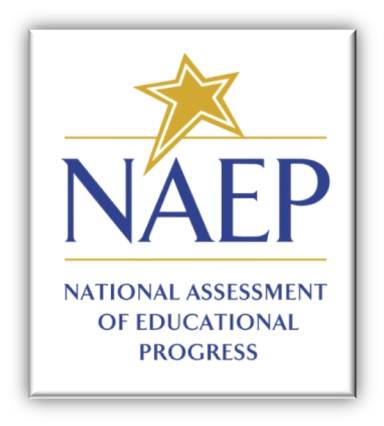NAEP
The National Assessment of Educational Progress (NAEP) is the largest nationally continuing evaluation of the condition of education in the United States. NAEP has served as a national yardstick of student achievement since 1969.
Through The Nation’s Report Card, NAEP informs the public what American students know in various subject areas and compares achievement among states, large urban districts, and various student groups.
NAEP is a congressionally mandated program administered by the National Center for Education Statistics (NCES) within the U.S. Department of Education.
The National Assessment Governing Board (NAGB) oversees and sets policy for NAEP.
Please take a moment to view the video: NAEP - The Nation’s Report Card
Please feel free to visit:
- National Assessment Governing Board (NAGB): www.nagb.gov
- National Center for Educational Statistics (NCES): www.nces.ed.gov
NAEP Participation Requirements
General Information
2022-2023 NAEP
The National Center for Educational Statistics (NCES) conducted a Long-Term Trend (LTT) age 13 assessment. Arizona was part of the national sample. Testing was conducted in October/November 2022. A Long-Term Trend age 13 assessment was conducted prior to the COVID-19 pandemic, and this administration is a repeat of the same schools that were in the sample in 2019.
On assessment day, students completed three 15-minute subject matter blocks in either reading or mathematics as well as completing a 5-minute questionnaire.
The LTT is taking place as a part of the National Assessment of Educational Progress (NAEP). NAEP is the largest nationally representative and continuing assessment of what students in the United States know and can do in various subjects. It is administered within the U.S. Department of Education. Selected schools represent schools across the nation and provide an accurate picture of student performance. The data collected can be linked to NAEP assessments conducted in the early 1970s to measure progress over time. National-level results will be released as The Nation's Report Card. Information about NAEP can be found at https://nces.ed.gov/nationsreportcard.
NAEP is also conducting a field test to research the feasibility of hybrid modes of NAEP administrations in the future. A sample of grade 4, 8, and 12 students was selected in Arizona. The field test will be administered in the Spring of 2023.
Arizona’s 10-Year NAEP trend remains strong despite the COVID-19 pandemic
The National Center for Educational Statistics (NCES) has released fourth and eighth grade math and reading results from the 2022 administration of NAEP. As Arizona continues to tackle numerous challenges through the pandemic, the Arizona 10-year trend (2011-2022) for NAEP scale scores remains strong. Arizona is now in the national average in grade 4 and 8 Math and Reading.
The Arizona scale score changes in the 10-year trend (2011-2022) are as follows:
-1.8 in Grade 8 Reading - (compared to the nation losing 4.2 points; only 5 states in the nation exhibited a better trend)
-8 in Grade 8 Math - (compared to the nation, which was a 9.5-point decline)
+3 in Grade 4 Reading - (compared to the national average, which was a 4-point decline. There were only 2 states in the nation exhibiting stronger growth over the 10-year period.)
-3 in Grade 4 Math - (compared to the nation, which exhibited a 5-point decline)
2022 Arizona Grade 4 Math
- In 2022, the average score of fourth-grade students in Arizona was 232. This was not significantly different from the average score of 235 for public school students in the nation.
- The average score for students in Arizona in 2022 (232) was lower than their average score in 2019 (238) and was higher than their average score in 2000 (219).
- The percentage of students in Arizona who performed at or above the NAEP Proficient level was 32 percent in 2022. This percentage was smaller than in 2019 (37 percent) and was greater than in 2000 (16 percent).
2022 Arizona Grade 8 Math
- In 2022, the average score of eighth-grade students in Arizona was 271. This was not significantly different from the average score of 273 for public school students in the nation.
- The average score for students in Arizona (271) was lower than their average score in 2019 (280) and was not significantly different from their average score in 2000 (269).
- The percentage of students in Arizona who performed at or above the NAEP Proficient levels was 24 percent in 2022. This percentage was smaller than in 2019 (31 percent) and was not significantly different than in 2000 (20 percent).
2022 Arizona Grade 4 Reading
- In 2022, the average score of fourth-grade students in Arizona was 215. This was not significantly different from the average score of 216 for public school students in the nation.
- The average score for students in Arizona in 2022 (215) was not significantly different from their average score in 2019 (216) and was higher than their average score in 1998 (206).
- The percentage of students in Arizona who performed at or above the NAEP Proficient level was 31 percent in 2022. This percentage was not significantly different than in 2019 (31 percent) and was greater than in 1998 (22 percent).
2022 Arizona Grade 8 Reading
- In 2022, the average score of eighth-grade students in Arizona was 259. This was not significantly different from the average score of 259 for public school students in the nation.
- The average score for students in Arizona in 2022 (259) was not significantly different from their average score in 2019 (259) and in 1998 (260).
- The percentage of students in Arizona who performed at or above the NAEP Proficient level was 28 percent in 2022. This percentage was not significantly different than in 2019 (28 percent) and in 1998 (27 percent).
For information about NAEP, contact us at [email protected].








